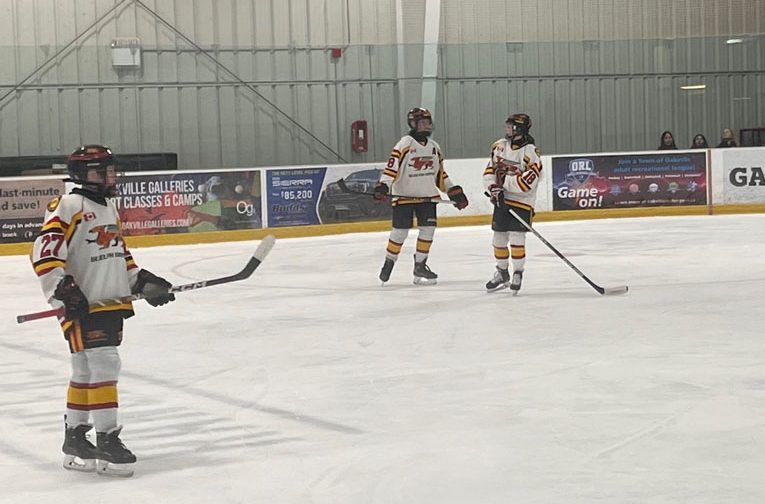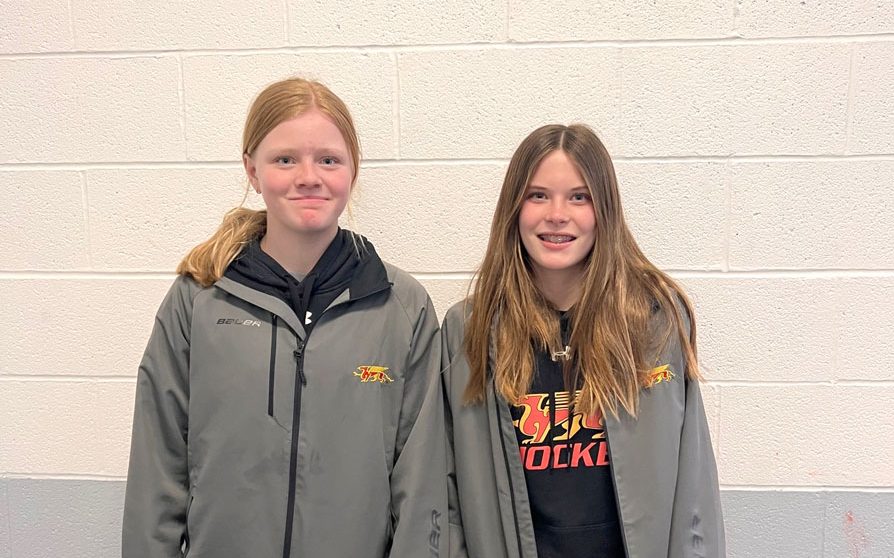CENTRE WELLINGTON – Addyson Martin and Briar Decker were doused with water after their last game of the season with the Guelph Boys U13 AAA hockey team.
Last game of the season – and last time playing with the boys.
“We lost our last game,” said coach James Prigione of the March 25 game. “But we played it like a send-off for the girls.
“I had them in the starting lineup and let them play the last minute and a half. I think it meant a lot to the boys, too.
“They showered the girls with water bottles. It was a celebration of how happy they are for the girls. It brought a tear to my eye.”
It’s not unique anymore for girls to play hockey, or even to play on a boys’ team.
But Martin and Decker have been playing on the boys AAA team for four years.
Next year, as the age level advances, there is contact. And there will also be change room issues.
So the girls, who both have Olympic dreams, will have to move over to the girls’ hockey stream.
“It’s been fun,” Decker said of playing with boys. “They are different. They push pretty hard.”
“I got a lot of good coaching and development and made a lot of friends,” added Martin.
“Everyone here has been supportive. I never had anything bad happen.”
Decker is 13 and lives in Grand Valley.
She started playing house league hockey when she was five on a team that had a mix of girls and boys.
She was good. And after three years of house league, her dad took her to AAA tryouts in Guelph and she made the team.
Martin is 12 and lives in Elora. She started skating when she was two and joined house league at four.
She played for the Grand River Mustangs girls team for a year, then switched to the Centre Wellington Fusion A boys team.
Martin tried out for the Guelph AAA team, made the cut, and never looked back.
“I love hockey,” she said. “As soon as I go on the ice, everything else disappears.
“It’s fun, I work hard, and I like to compete. I think it’s a faster game with the boys.”
Stories like this make Sheila Keane’s heart warm.
She is the coach of the Mustangs’ development team – also known as the select team – and she’s seen many girls work their way through select and go on to rep teams at either the A or BB level.

Briar Decker and Addyson Martin, right, confer during their last game with the Guelph boys U13 AAA team on March 25. Submitted photo
Keane, who grew up in Elora and still lives there, is now 47.
But when she was 10, she joined ringette because there was no hockey for girls in the area.
“I could have played on a boys’ team I suppose,” she said in an interview.
“I didn’t know any girls that did though.”
Ringette is not easier than hockey, she said, and over her time playing the game, rules were added and changed to make the game more competitive and challenging.
And she learned excellent skating skills with ringette, which served her well as she transitioned to hockey on a recreational team as an adult.
When she attended the University of Guelph in the 1990s, Cassie Campbell was a student and star player of the Gryphons hockey team.
Campbell went on to be one of the first players on Canada’s first Olympic women’s hockey team, winning a silver in 1998, and gold medals in 2002 and 2006.
“That’s when I really started watching women’s hockey,” Keane said.
“And that’s when women’s hockey really took off.”
According to Hockey Canada’s website, there were just shy of 8,000 girls playing on 557 registered teams in Ontario in 1993.
By 2003 that had jumped to 31,000 players in female leagues in Ontario.
And by the 2019-20 season, more than 50,000 girls were registered to play hockey, representing 21 per cent of all hockey registrations in Ontario.
The Grand River Mustangs, the home of girls’ hockey in the Centre Wellington area, formed in 2005 and has grown its house, select and rep teams, both in numbers and the calibre of players.
Keane said there are many girls who play on boys’ teams and there’s no reason not to. Hockey is hockey after all, and there’s not much difference when kids are on the ice.
“But it’s the change room thing,” Keane said. “They’re in there for half-an-hour and that’s when a lot of important stuff happens.
“That’s where the friendships form.”
Keane said she offered her two daughters hockey or ringette as they were growing up and they both opted for hockey.
“They saw me playing hockey and both wanted hockey. That’s gratifying,” she said.
“But to coach my daughters, to be with them on the bench – that’s the best experience you can have.”
In a follow up email, Keane noted it takes a village to build a hockey league.
“A big part of the success of girls’ hockey has been the amount of volunteers on the board and coaching,” she said.
“We have so many coaching, in particular fathers of the players who played high level hockey and who have helped in player development.
“I can’t believe how much the skill level has progressed in girls’ hockey over the years,” she continued.
“And I hope these players become some of the future coaches of their daughters, which is what we are starting to see now.”
With their last season with the boys behind them, Decker and Martin are looking to the future.
Decker said she’s trying out for a girls’ U15 AA team in Mississauga.
Martin hopes to get a spot on a girls’ U15 AA team in Waterloo.
It’s not a step backwards, Decker said.
“The opportunity to go to girls’ hockey is we’ll be scouted more,” she said.
“I’m pretty excited to play with girls and a new coach.”
The most refreshing part of this story is that neither Decker nor Martin faced discrimination.
They didn’t have to fight a gender battle to get on a team.
And they don’t have to fight a gender battle to advance their skills or even find a career in hockey.
Their battles will be on the ice, as with any hockey player.
“It’s bittersweet that this is their last season with the boys,” said Addyson’s mother Kendra Martin.
“They had such a great experience.”




